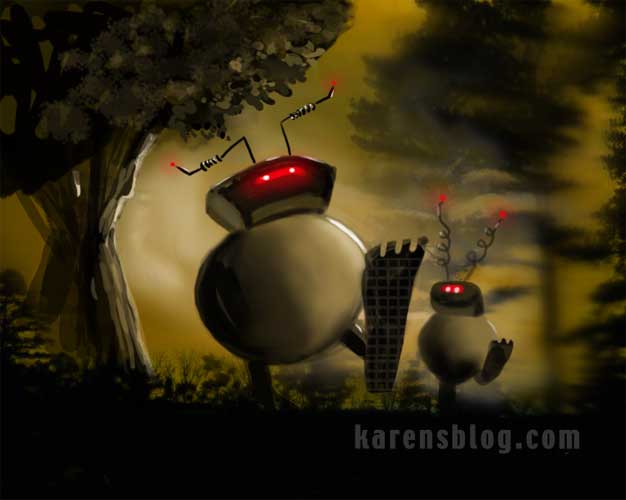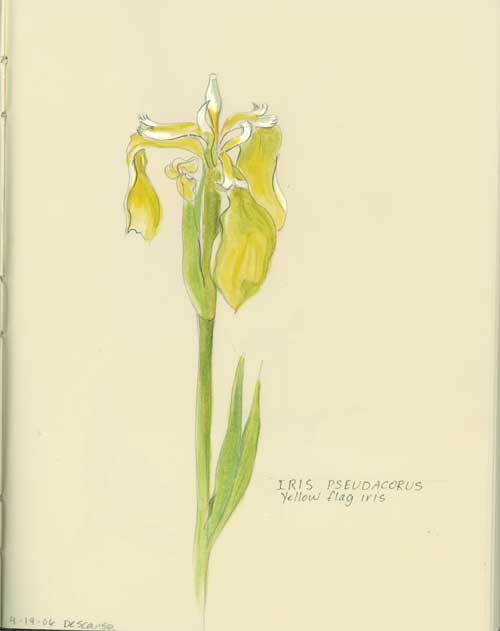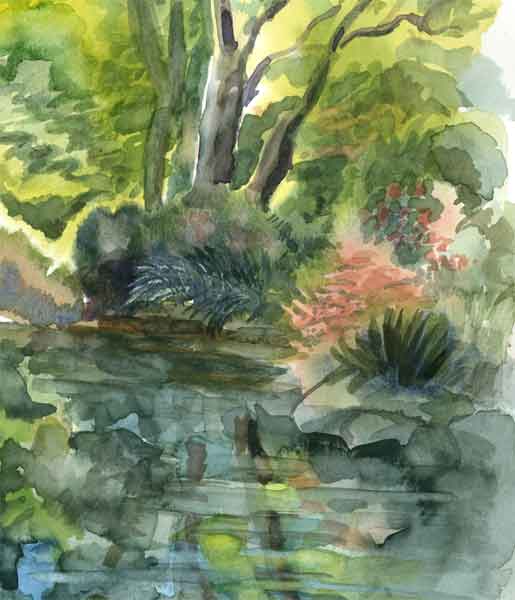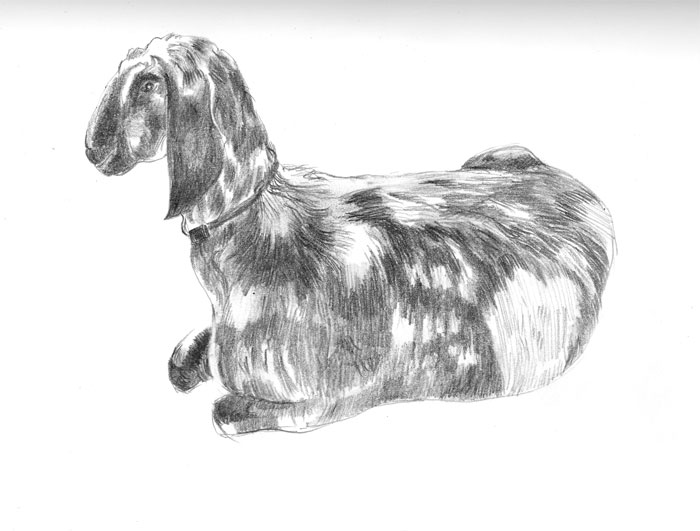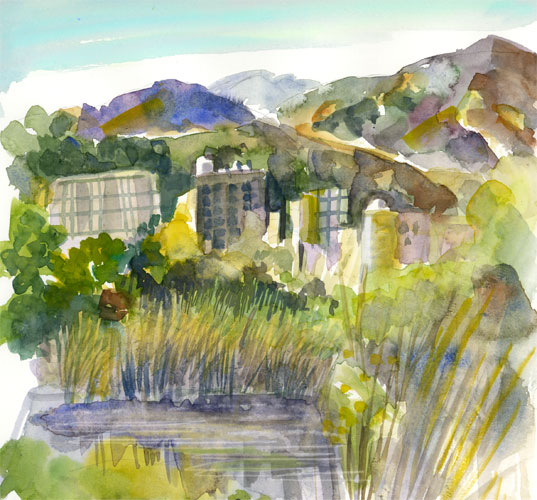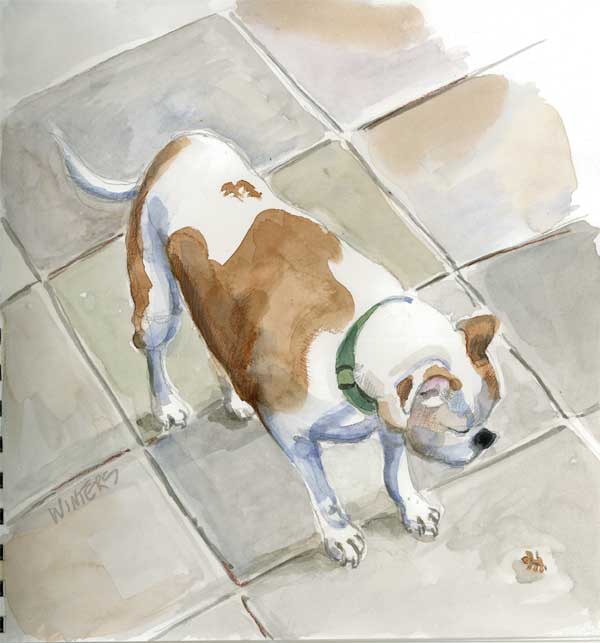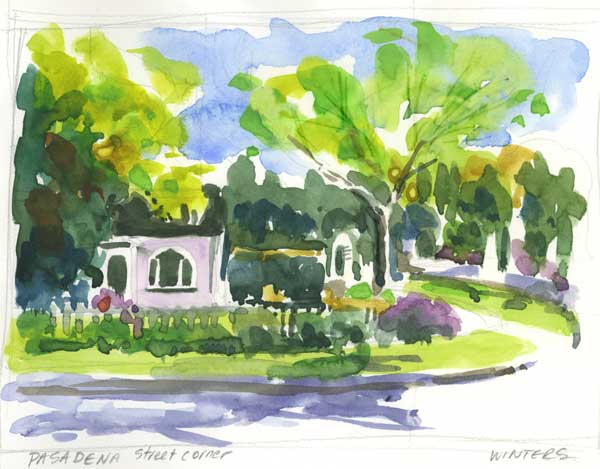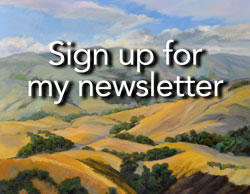George
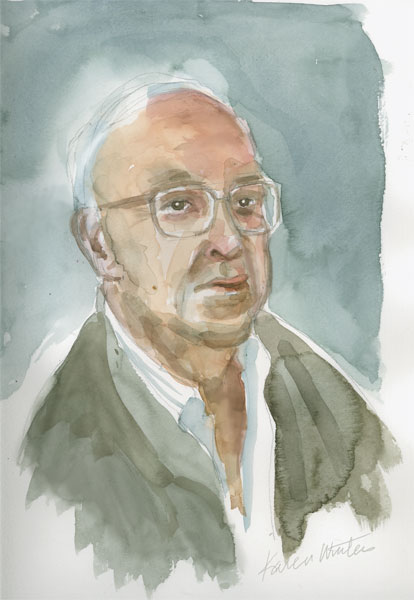
I got a late start but decided I would take part in Wet Canvas’ All Media Event. It’s a pretty interesting activity. Reference photos are posted over the weekend and you have a half an hour to select one and two hours to finish your piece (unless you don’t, and then you can post it as a work in progress.) This took me more than an hour, but less than an hour and a half, somewhere in there. I was working quickly – it’s little more than a sketch, really, but it was fun to do. You can execute your piece of work in any medium you want. I need practice in painting people so I picked this one and changed the background and attitude of the head to suit myself.
Illo Friday – Robot
Robots don’t work all the time, you know. Sometimes they go for walks in the woods with their kids. And pick berries and stuff. So, if you’re camping and you see glowing red eyes in the bushes … just remember, it might not be bobcats …
Yellow flag
A recent entry in my ‘purely botanical’ sketchbook. This yellow flag iris is quite commonly planted around bogs or ponds. This one grows at Descanso gardens near a pond with a weeping willow. This iris, native to Asia and Europe, became known as the French fleur-de-lis, and the word “flag” may refer to a non-English word meaning rush or reed.
In some US states, pseudarcorus is considered a noxious weed because it grows by both underground tubers and reeds and can be invasive. We have a small patch of them in our yard and they have been very well contained in dry years. In very wet seasons they do spread a little bit.
Watercolor in a coptic bound Paperblanks journal with creamy paper
Three Sisters at the pool
Descanso Gardens changes by the season, the day, sometimes by the minute. Especially when the morning sun is weaving and dodging through the dense canopy of oak trees. Yesterday I was so captivated by the morning light that I spent the first hour there shooting photos for reference. In the Japanese garden, one of my favorite areas, the light was changing so rapidly that even ten minutes might highlight a plant that had been in deep shade before. Not even enough time for a wash to dry before it utterly changed. When the light is steady – either full sun or full shade – this is not so much of a problem unless there are moving clouds. Take a look at a time lapse movie and the challenge of changing light will become readily apparent.
I tried cropping this differently, and I think I like it better.
Watercolor in a Canson Montval 7 x 10 watercolor field book
Spotted Nubian – Illo Friday
Click to enlarge
I got busy this week and missed the chance to do something for Illustration Friday. So here’s something done earlier this year that wasn’t used for any previous project …
If you’re a regular reader, you know that I very seldom do any graphite drawing. I don’t have any negative feelings about it. In fact, I love the beautiful halftones that some of my artist friends like Detlef and Felicity so skillfully achieve. For some reason, perhaps negative experiences drawing with a pencil when I was a child, I just don’t gravitate to it. So today, as part of my ongoing animal series I decided to do something radical and to draw this spotted Nubian goat in graphite instead of ink or paint. The paper was not particuarly smooth or fine, much to my regret. I used 2B, 6B and 8B pencils, a kneaded eraser and a tortillon here and there.
(Edited to add: The paper size was 8 1/2 x 11 – for some idea of scale. K.)
In reality the goat is colored burnt sienna, deep burnt umber, black and white. Maybe I’ll try her in watercolor next. After I finish cleaning my refrigerator, that is.
Arroyo Twilight
I think I tend to be a little too conservative with color. It’s a rut I’m trying to get out of by occasionally getting experimental and pushing the colors far beyond realism. So, today my husband and I went out for a little “golden hour” painting time – the last 25 minutes of the day before the sun went behind the nearby Verdugo Hills. There wasn’t time to fiddle and fuss about being neat or getting the shapes and values right – the light was changing rapidly by the minute. I had a very good time splashing around while he read to me about Calder from today’s LA Times.
This watercolor sketch is another view of the same arroyo I painted last week – an area that is either dustbowl dry or full of water depending upon the season. Right now there are cattails in a marshy area – redwinged blackbirds everywhere and ponds full of poliwogs. It’s my idea of a great painting location.
If you draw or paint, in what areas are you ‘pushing yourself’ to be more experimental, regardless of the outcome? Are you taking chances? How does it feel when you do?
Ripley again …
It’s been a few weeks since Ripley has made an appearance here and she was calling that to my attention earlier today. So here you are.
Because I know someone will ask, I will answer it ahead of time – I did not paint this from life. In fact, here’s the secret code to to figuring out whether a particular Rip-painting has been done from life. If Ripley is sleeping or lounging in a mostly horizontal position, there’s a good chance it was done from life. If she appears to be standing up, bouncing around, digging, begging, panting or wearing a plumed hat and pearls, there’s a good chance it was painted from a photo. I do sketch her from life a lot, but mostly when the switch is set to ZZZZZZZZZZZ.
Pasadena spring
A watercolor sketch of a local streetcorner, influenced in part by a recent demo I saw by Joseph Stoddard, who is, himself, a student of Charles Reid. I think I’m going to be leaving the Niji waterbrushes behind for plein-air sketching, or else I’ll be using a lot more water for juicier washes.
Still pursuing camellias
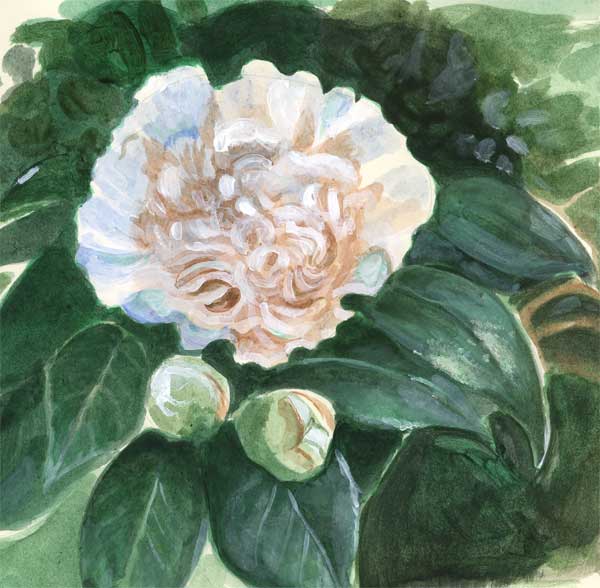
I’m still in search of the secret of shiny leaves. So here I am, Day 2, after a night’s sleep. (See the day before yesterday for my first attempt, in watercolor.) This is an experiment in acrylic, suggested by Cynthia on the botanical art list. I have very little experience with acrylic – my practice has been almost completely in watercolor and pen and ink – but acrylic is starting to grow on me.
Watercolor is a stern taskmistress. She’s like the Olympics. You get one try on the 10 meter board and if you do a belly flop there are no do-overs, you just have to go find another piece of paper and try again. (Unless you can lift or scrub your mistake out, but that’s a different story.
Acrylic is like your favorite aunt that says “Relax, have fun, you’ve got a little wiggle room. Don’t stress.”
That being said, I’m still not satisfied with the leaves but I like the fluffy camellia a bit and most of all I liked the experience. I am always surprised with what a project teaches me; it’s never what I would expect. Maybe that’s what makes art such an addictive experience. There’s always something new to learn and you can mix it up infinitely and never, ever be bored.
Some leaf and flower studies
Last night, an art friend mentioned the book Botanical Illustration by Siriol Sherlock, and I pulled out my copy and read a little before going to bed.
Big mistake.
I turned fitfully and dreamed of impossible leaves and flowers and woke up in about two hours, probably due to Ripley snoring. But once awake, I couldn’t get those illustrations out of my mind. So I toddled down to my studio and studied some of the instructions, and then used some of my own reference photos to practice what I read on a scrap of watercolor paper. Modeling shiny surfaces wet in wet is going to take a lot of practice before I get any measure of comfort.
Do you ever get that way with an art project – where it grabs you and won’t let you go until you practice something or try something out?
